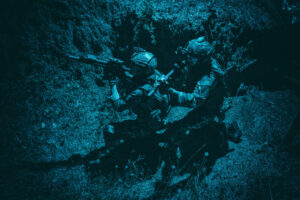For 22 years after Sept. 11, 2001, U.S. Special Operations Forces (SOF) served as the tip of the spear in the global war on terrorism. Night after night, SOF warriors hunted terrorists by land, air and sea. In daring raids, they rescued hostages, freed prisoners and captured or killed the most dangerous enemies of the United States.
Many SOF personnel who enlisted after 9/11 served more than 10 tours, fighting two major wars in Afghanistan and Iraq, followed by conflicts in Syria and other theaters of conflict that remain classified. From the first SOF actions in Tora Bora, Afghanistan, to the capture of Saddam Hussein, to the raids that killed Osama bin Laden and Abu Bakr al-Baghdadi, SOF personnel carried out sensitive and dangerous missions critical to the security of the United States and its allies.
The toll of this responsibility on the silent professionals of the SOF community was substantial. Hundreds died in combat, thousands more were wounded, and countless families were without their loved ones for extended periods of time. Yet SOF warriors continued to serve at an unprecedented operational tempo, aware of the risks to their lives, health and families.
Now that America’s longest wars are winding down, the effects of two decades of conflict and a staggering frequency of deployments are beginning to emerge. A generation of SOF, many in their late-30s and early 40s, is transitioning to “shore-jobs” in the U.S. or retiring and transitioning to civilian life. Some of the most experienced, combat-tested SOF warriors in the history of our nation are coming home.
The health impact on the brain is the greatest
When the focus and adrenaline of combat fades, its adverse health effects come into clear relief. Beyond the visible wounds, the impact of two decades of war is greatest on the brain. Individual experiences vary, but SOF personnel report a broad spectrum of neurological and psychological symptoms that include headaches, insomnia, dizziness, tinnitus, memory difficulties, inattention, aggression and depression. Whether these symptoms will improve with time or progress to a debilitating neurodegenerative disease is a question whose answer will reverberate – with cost and consequence – throughout the SOF community and the broader military for decades.
Current knowledge about mechanisms of neuropsychological symptoms in post-9/11 military personnel is riddled with holes. The most substantial gap in knowledge about SOF brain health is the uncertain impact of repeated blast exposure. SOF personnel are frequently exposed to explosive blasts during training and combat – from small, medium and large arms, as well as improvised explosive devices. Yet the effects of repeated blast exposure on their brains are not fully understood. As a result, servicemembers may experience symptoms that go undiagnosed, and they may return to training and combat during a time of brain vulnerability.
Repeated blast exposure is a paramount concern
Unanswered questions about the effects of repeated blast exposure are of immediate importance to a new generation of SOF warfighters who continue to serve at the tip of the spear. SOF personnel remain globally engaged to prevent terrorist attacks from coming to the homeland, while also preparing for large-scale combat operations against potential adversaries. This mission requires superior cognitive flexibility and psychological resilience as much as superior physical performance.
Yet for the clinicians who provide medical care to SOF personnel, there is a lack of tools to understand the underlying cause of cognitive and psychological symptoms. For SOF commanders, they must make decisions about the combat readiness and performance capabilities of their teams without access to critical information about the team’s brain health.
This landscape of uncertainty is beginning to clear.
A compelling and growing body of evidence indicates that repeated blast exposure disrupts the brain’s structural and functional integrity. Though a single blast may not immediately cause symptoms, the cumulative effects of thousands of subconcussive blasts may lead to pathological changes within neurons, blood vessels and immune cells, which in turn disrupt the neural networks that modulate higher-level cognition and behavior.
Phenomenologically, the gradual onset of symptoms in SOF personnel is similar to that of contact sport athletes – repeated exposure to explosive blasts may injure a servicemember’s brain, just as repeated exposure to blunt contact trauma may injure a football player’s brain.
Yet the pathological changes seen under the microscope differ. Repeated blast brain injury does not appear to cause chronic traumatic encephalopathy, the pathological process described in contact sport athletes. Rather, military personnel with repeated blast exposure have heterogeneous types and patterns of abnormal proteins deposited within their brains, and evidence is emerging from brain autopsy studies of blast-exposed military personnel that scarring at the gray-white matter interface is a unique pathological signature of repeated blast brain injury.
The limits of available diagnostic tests
Crucially, this brain scarring is not detectable by currently available diagnostic tests. As a result, a servicemember who seeks medical evaluation for neuropsychological symptoms typically has a normal-appearing brain on a standard magnetic resonance imaging (MRI) scan. While there is now a medical diagnostic code for a single blast-related traumatic brain injury, no such diagnostic code exists for repeated blast brain injury, leaving clinicians without a taxonomy for classifying the symptoms that servicemembers experience. Without a visible abnormality on brain MRI or a diagnostic code, clinicians often view a servicemember’s symptoms through the lens of psychiatric diagnoses such as post-traumatic stress disorder (PTSD). Indeed, the Venn diagram of symptoms associated with PTSD and blast-related brain injury has extensive overlap.
Yet a recent study of 30 active-duty U.S. SOF personnel found that the association between cumulative blast exposure and brain network alterations was not attributable to PTSD symptoms.
Using advanced MRI and positron emission tomography (PET) scans, this study identified changes within a widely connected brain network hub in the frontal lobe – the anterior cingulate cortex – that modulates human cognition and emotion.
Three lines of evidence – structural, functional, and neuroimmune – converged to show that higher levels of blast exposure were associated with alterations in this brain network hub. These findings provide a potential biological basis for neuropsychological symptoms that were previously believed to be related to PTSD or not given a formal diagnosis. Notably, the location of the anterior cingulate cortex behind the eyes is consistent with prior biomechanical studies, which indicate that blast overpressure waves penetrate openings in the skull, including those behind the eyes.

New tools within reach
We are now at a critical crossroads where advanced imaging technologies may soon allow us to see the “invisible wounds of war.” While recent research studies do not provide sufficient evidence for immediate clinical implementation of a diagnostic test for repeated blast brain injury, such a test appears to be within reach.
To realize this goal, three essential attributes must be incorporated into future studies of repeated blast brain injury: 1) larger sample sizes; 2) longitudinal assessments that link changes in blast exposure to changes in symptoms, imaging biomarkers and blood biomarkers; and 3) measurement of the myriad exposures, beyond blast, that SOF personnel experience in training and combat.
The importance of the latter point cannot be overstated.
SOF personnel operate in extreme environmental conditions that expose them to low oxygen levels while parachuting from high altitudes or deep-sea diving, acceleration G-forces while traveling in aircraft or boats at high speed, and inhalation of heavy metal fumes while firing munitions. Only if future research studies measure and statistically account for these additional exposures can we mechanistically link blast exposure to brain injury and thereby validate a diagnostic test for repeated blast brain injury.
Our country needs a multifaceted approach, embraced by the military, civilians and Congress, to support SOF warfighters who continue to protect and defend our freedoms.
More must be done
The Department of Defense has taken positive steps, including by the Assistant Secretary of Defense for Special Operations/Low-Intensity Conflict and the Special Operations Command. In 2013, these offices launched Preservation of the Force and Family (POTFF), a proactive and holistic approach to supporting SOF brain health.
Also, the Department of Defense in 2022 launched the Warfighter Brain Health Initiative, which is building a comprehensive infrastructure to optimize clinical care for the entire military community. With its creation of a Traumatic Brain Injury Center of Excellence, the Warfighter Brain Health initiative places blast-related brain injury at the center of its mission. This Center of Excellence is integrating efforts by researchers and clinicians to improve evidence-based care for military personnel with brain injuries.
Still, more must be done.
There is not currently a clear path for SOF personnel, or servicemembers from other occupational specialties with high blast exposure, to receive a definitive diagnosis for cognitive or psychological symptoms associated with repeated blast brain injury.
While we strongly support the Larkin-Froede Blast Overpressure Safety Act now being debated in Congress, it does not sufficiently prioritize the development of a diagnostic test for repeated blast brain injury. The bill’s prioritization of prevention and treatment is laudable, but we cannot optimally prevent or treat a brain injury until we can diagnose it.
A roadmap for Congress and the administration
Congress should also consider supplemental funding for fiscal 2025 appropriations directed at diagnostics and mitigating technologies. Congress and the DOD should program these efforts into future presidential budgets to ensure that resources are available to address these current and emerging challenges, perhaps the most important investment that we as a country can make.
We owe the SOF community our unwavering support and commitment to providing them with the best possible medical care through research and innovation. There are numerous gaps in knowledge to fill and many aspects of clinical care to improve.
A diagnostic test for repeated blast brain injury is the foundation upon which prevention and treatment will be built. With a reliable diagnostic test, we can optimize the combat readiness, career longevity, and quality of life of America’s elite warfighters. The future of the SOF community, and its ability to maintain a competitive advantage, depends on our support.






